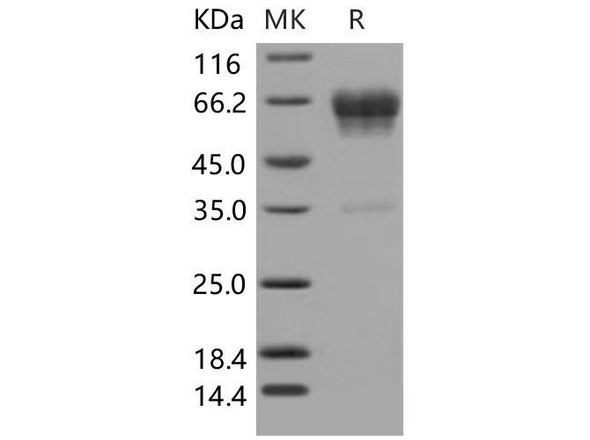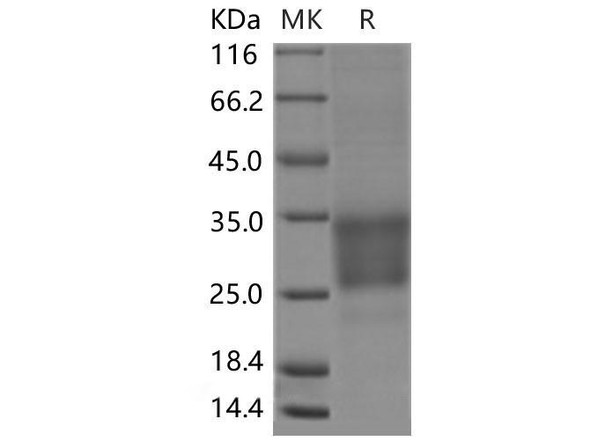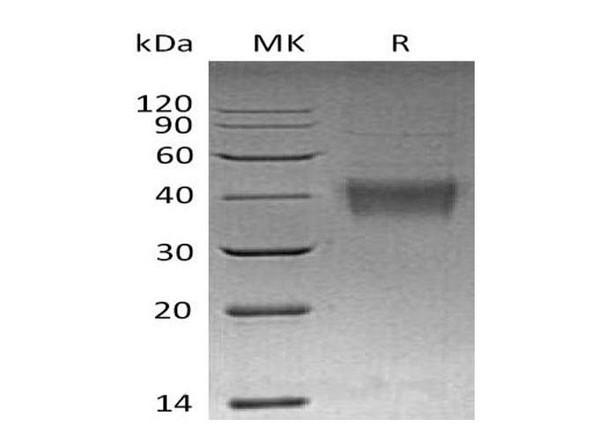Description
| Product Name: | Mouse TNFR2 Recombinant Protein |
| Product Code: | RPPB1014 |
| Size: | 20µg |
| Species: | Mouse |
| Target: | TNFR2 |
| Synonyms: | Tumor necrosis factor receptor superfamily member 1B, Tumor necrosis factor receptor 2, TNF-R2, Tumor necrosis factor receptor type II, TNF-RII, TNFR-II, p75, p80 TNF-alpha receptor, CD120b, Tnfrsf1b, Tnfr-2, Tnfr2, TNFBR, TNFR80, TNFRII, TNF-R75, TNF-R-II, TNF-alphaR2, TNFalpha-R2. |
| Source: | Escherichia Coli |
| Physical Appearance: | Sterile Filtered White lyophilized (freeze-dried) powder. |
| Formulation: | TNFR2 protein was lyophilized from a 0.2�m filtered concentrated solution in PBS, pH 7.4. |
| Solubility: | It is recommended to reconstitute the lyophilized TNFR2 in sterile 18M-cm H2O not less than 100�g/ml, which can then be further diluted to other aqueous solutions. |
| Stability: | Lyophilized TNFR2 although stable at room temperature for 3 weeks, should be stored desiccated below -18C. Upon reconstitution TNFR2 should be stored at 4C between 2-7 days and for future use below -18C. For long term storage it is recommended to add a carrier protein (0.1% HSA or BSA). Please prevent freeze-thaw cycles. |
| Purity: | Greater than 97.0% as determined by SDS-PAGE. |
| Amino Acid Sequence: | VPAQVVLTPY KPEPGYECQI SQEYYDRKAQ MCCAKCPPGQ YVKHFCNKTS DTVCADCEAS MYTQVWNQFR TCLSCSSSCT TDQVEIRACT KQQNRVCACE AGRYCALKTH SGSCRQCMRL SKCGPGFGVA SSRAPNGNVL CKACAPGTFS DTTSSTDVCR PHRICSILAI PGNASTDAVC APESPTLSAI PRTLYVSQPE PTRSQPLDQE PGPSQTPSIL TSLGSTPIIE QSTKGG |
| Biological Activity: | The ED50 as determined by its ability to inhibit the TNF-a mediated cytotoxicity in the L-929 cells is less than 2�g/ml, corresponding to a specific activity of > 500IU/mg in the presence of 0.1ng/mL of rHuTNF-a. |
TNFR2 belongs to the TNF-receptor superfamily. TNFR2 is receptor with high affinity for TNFSF2/TNF-alpha and approximately 5-fold lower affinity for homotrimeric TNFSF1/lymphotoxin-alpha. TNFR2 mediates the majority of the metabolic effects of TNF-alpha. In addition, knockout studies in mice propose a role for TNFR2 in protecting neurons from apoptosis by stimulating antioxidative pathways. TNFR2 expression might have a significant role in the angiogenesis, tumor cell proliferation and metastasis of Invasive micropapillary carcinoma of the breast.There are 2 types of soluble TNF receptors: sTNFR-I and sTNFR-II, which act to neutralize the biological activities of TNF alpha and TNF beta. The levels of these soluble receptors seem to increase as a result of shedding of the extracellular domains of the membrane bound receptors. High levels of soluble TNF receptors are found in the amniotic fluid of pregnant women. TNFR2 and TNFR1 form a heterocomplex which mediates the recruitment of 2 anti-apoptotic proteins, c-IAP1 and c-IAP2, which possess E3 ubiquitin ligase activity. IAPs� function in TNF-receptor signaling is unknown; nevertheless, c-IAP1 is believed to potentiate TNF-induced apoptosis by the ubiquitination and degradation of TNF-receptor-associated factor 2, which mediates anti-apoptotic signals. Oxidative stress promotes TNFR1 and TNFR2 self-interaction, ligand-independent and enhanced ligand-dependent TNF signaling. TNF-a, TNFR1 and TNFR2 have roles in cellular differentiation. TNFR1 and TNFR2 function in cell type-specific renal injury.
TNFR2 Mouse Recombinant produced in E.coli is a single, non-glycosylated polypeptide chain containing 236 amino acids and having a molecular mass of 25.3kDa.The TNFR2 is purified by proprietary chromatographic techniques.
| UniProt Protein Function: | TNF-R2: Receptor with high affinity for TNFSF2/TNF-alpha and approximately 5-fold lower affinity for homotrimeric TNFSF1/lymphotoxin-alpha. The TRAF1/TRAF2 complex recruits the apoptotic suppressors BIRC2 and BIRC3 to TNFRSF1B/TNFR2. This receptor mediates most of the metabolic effects of TNF-alpha. Isoform 2 blocks TNF-alpha-induced apoptosis, which suggests that it regulates TNF-alpha function by antagonizing its biological activity. Binds to TRAF2. Interacts with BMX. 2 isoforms of the human protein are produced by alternative splicing. |
| UniProt Protein Details: | Protein type:Membrane protein, integral; Receptor, cytokine Cellular Component: cell soma; membrane; axon; perinuclear region of cytoplasm; integral to membrane; intracellular; nucleus; lipid raft Molecular Function:protein binding; tumor necrosis factor receptor activity; ubiquitin protein ligase binding Biological Process: cell proliferation; cell surface receptor linked signal transduction; DNA damage response, signal transduction resulting in induction of apoptosis; tumor necrosis factor-mediated signaling pathway; negative regulation of inflammatory response; programmed cell death; immune response; inflammatory response; RNA destabilization; positive regulation of membrane protein ectodomain proteolysis |
| UniProt Code: | P25119 |
| NCBI GenInfo Identifier: | 135963 |
| NCBI Gene ID: | 21938 |
| NCBI Accession: | P25119.1 |
| UniProt Secondary Accession: | P25119,O88734, P97893, |
| UniProt Related Accession: | P25119 |
| Molecular Weight: | 50,320 Da |
| NCBI Full Name: | Tumor necrosis factor receptor superfamily member 1B |
| NCBI Synonym Full Names: | tumor necrosis factor receptor superfamily, member 1b |
| NCBI Official Symbol: | Tnfrsf1b�� |
| NCBI Official Synonym Symbols: | p75; TNFBR; Tnfr2; CD120b; TNF-R2; TNFR80; TNFRII; Tnfr-1; TNF-R75; TNF-R-II; TNF-alphaR2; TNFalpha-R2�� |
| NCBI Protein Information: | tumor necrosis factor receptor superfamily member 1B; TNF-RII; TNFR-II; p75 TNFR; p80 TNF-alpha receptor; TNF receptor beta chain; tumor necrosis factor receptor 2; tumor necrosis factor receptor type II |
| UniProt Protein Name: | Tumor necrosis factor receptor superfamily member 1B |
| UniProt Synonym Protein Names: | Tumor necrosis factor receptor 2; TNF-R2; Tumor necrosis factor receptor type II; TNF-RII; TNFR-II; p75; p80 TNF-alpha receptor; CD_antigen: CD120b |
| Protein Family: | Tumor necrosis factor receptor superfamily |
| UniProt Gene Name: | Tnfrsf1b�� |
| UniProt Entry Name: | TNR1B_MOUSE |










